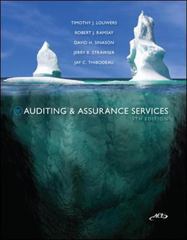Question
Interpreting Disclosure on Employee Stock Options Assume Intel Corporation reported the following in its 2008 10-K report. Share-Based Compensation Effective January 1, 2006, we adopted
Interpreting Disclosure on Employee Stock Options Assume Intel Corporation reported the following in its 2008 10-K report. Share-Based Compensation Effective January 1, 2006, we adopted the provisions of SFAS No. 123(R) . . . Share-based compensation recognized in 2008 was $852 million ($952 million in 2007 and $1,375 million in 2006). We use the Black-Scholes option pricing model to estimate the fair value of options granted under our equity incentive plans and rights to acquire common stock granted under our stock purchase plan. We based the weighted average estimated values of employee stock option grants and rights granted under the stock purchase plan, as well as the weighted average assumptions used in calculating these values, on estimates at the date of grant, as follows:
| Stock Options | 2008 | 2007 | 2006 |
|---|---|---|---|
| Estimated fair values | $ 5.74 | $ 5.79 | $ 5.21 |
| Expected life (in years) | 5.0 | 5.0 | 4.9 |
| Risk-free interest rate | 3.0% | 4.5% | 4.9% |
| Volatility | 37% | 26% | 27% |
| Dividend yield | 2.7% | 2.0% | 2.0% |
Additional information with respect to stock option activity is as follows:
| (In Millions, Except Per Share Amounts) | Number of Shares | Weighted Average Exercise Price |
|---|---|---|
| December 31, 2005 | 899.9 | $26.71 |
| Grants | 52.3 | $20.04 |
| Exercises | (47.3) | $12.83 |
| Cancellations and forfeitures | (65.4) | $28.07 |
| December 30, 2006 | 839.5 | $26.98 |
| Grants | 24.6 | $22.63 |
| Exercises | (132.8) | $19.78 |
| Cancellations and forfeitures | (65.4) | $31.97 |
| December 29, 2007 | 665.9 | $27.76 |
| Grants | 27.9 | $21.81 |
| Exercises | (38.6) | $19.42 |
| Cancellations and forfeitures | (42.8) | $31.14 |
| Expirations | (2.4) | $25.84 |
| December 27, 2008 | 610.0 | $27.79 |
(a) What did Intel expense for share-based compensation for 2008? Answer
($ million) How many options did Intel grant in 2008? Answer
(million shares) Compute the fair value of all options granted during 2008. (Round your answer to one decimal place.) Answer
($ million) Why do the fair value of the option grants and the expense differ?
The expense in 2008 is the cost of current and prior years' option grants that vest in the current year.
The expense is net of tax and the fair value of the options is pretax.
The expense includes both the value of the options and the opportunity cost reflecting the higher price at which the shares could have been sold.
The expense is related to the current market price of the stock and the options are granted at historical costs.
1.00 points out of 1.00
(b) Intel used the Black-Scholes formula to estimate fair value of the options granted each year. How did the change in volatility from 2007 to 2008 affect share-based compensation in 2008? What about the change in risk-free rate?
The increase in the volatility estimate decreased share-based compensation expense and the decrease in the risk-free rate estimate decreased compensation expense.
The increase in the volatility estimate decreased share-based compensation expense and the decrease in the risk-free rate estimate increased compensation expense.
The increase in the volatility estimate increased share-based compensation expense and the decrease in the risk-free rate estimate decreased compensation expense.
The increase in the volatility estimate increased share-based compensation expense and the decrease in the risk-free rate estimate increased compensation expense.
1.00 points out of 1.00
(c) How many options were exercised during 2008? Answer
million shares Estimate the cash that Intel received from its employees when these options were exercised. (Round your answer to one decimal place.) Answer
($ million) (d) What was the intrinsic value per share of the options exercised in 2008? (Hint: Assume that Intel grants options at-the-money.) $Answer
per share If employees who exercised options in 2008 immediately sold them, what "profit" did they make from the shares? (Round your answer to one decimal place.) Answer
($ million) (e) The tax benefit that Intel will receive on the options exercised is computed based on the intrinsic value of the options exercised. Estimate Intel's tax benefit from the 2008 option exercises assuming a tax rate of 34.7%. (Round your answer to one decimal place.) Answer
($ million)
Step by Step Solution
There are 3 Steps involved in it
Step: 1

Get Instant Access to Expert-Tailored Solutions
See step-by-step solutions with expert insights and AI powered tools for academic success
Step: 2

Step: 3

Ace Your Homework with AI
Get the answers you need in no time with our AI-driven, step-by-step assistance
Get Started


